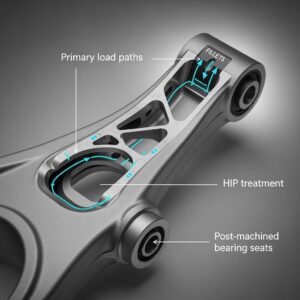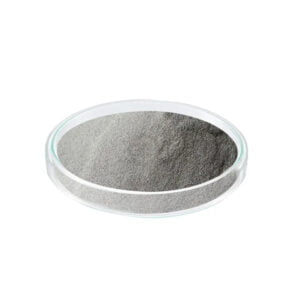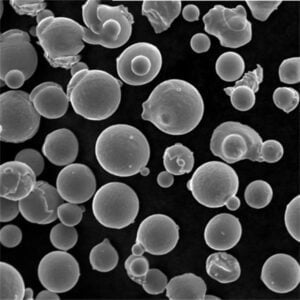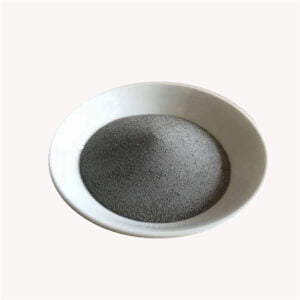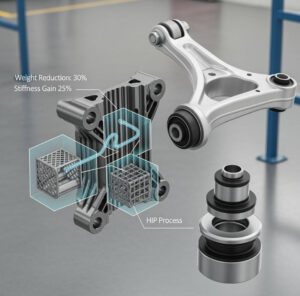전자빔 제조
목차
전자빔 제조 는 고에너지 전자의 집중된 빔을 사용하여 금속 분말 입자를 층별로 선택적으로 녹이고 융합하여 복잡한 3D 부품을 직접 제작하는 적층 제조 공정을 말합니다.
전자빔 용융(EBM) 또는 전자빔 분말 베드 융합이라고도 하는 이 공정은 제작 속도, 재료 특성, 표면 마감, 기하학적 자유도 등 기존 제작 방식과 비교할 수 없는 기능을 제공합니다.
이 가이드는 공정 기능, 재료, 애플리케이션, 시스템 공급업체, 장단점 비교, 도입 고려 시 자주 묻는 질문(FAQ) 등 전자빔 제조에 대한 개요를 제공합니다.
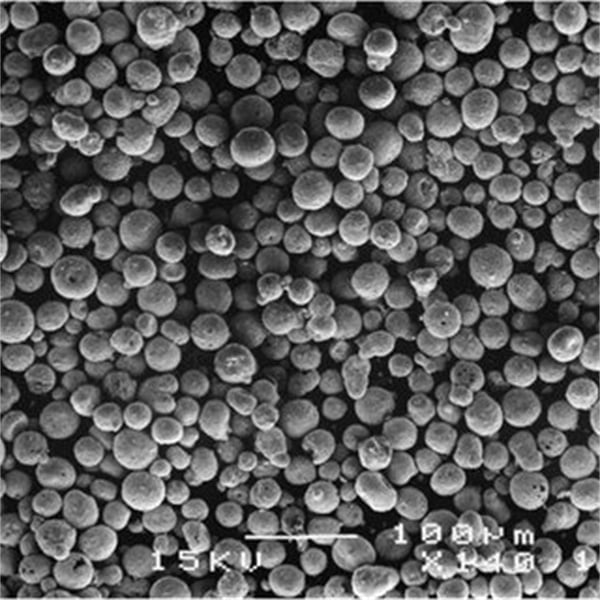
전자빔 제조 공정 개요
- 금속 분말이 빌드 플레이트에 균일하게 퍼짐
- 전자 빔 스캔은 파우더를 융합하는 경로를 정의합니다.
- 플레이트 인덱스가 아래로 향하고 새 레이어가 위에 펼쳐집니다.
- 열 예열로 공정 온도 유지
- 빌드 중 진공 상태로 유지되는 챔버
- 필요한 곳에 구조 지원
- 필요에 따라 최종 부품을 잘라내어 완성
전자 빔은 레이저보다 전도성 재료에 더 빠르고 깊숙이 침투할 수 있어 잔류 응력을 줄이면서 제작 속도를 높일 수 있습니다.
전자빔 제조에 사용되는 재료
화학 및 입자 크기 분포에 최적화된 다양한 합금을 가공합니다:
| 재질 | 일반적인 합금 | 개요 |
|---|---|---|
| 티타늄 합금 | Ti6Al4V, Ti6Al4V ELI | 고강도, 저중량의 항공우주 등급 블렌드 |
| 니켈 합금 | 인코넬 718, 625, 헤인즈 282 | 터빈용 내열/내식성 초합금 |
| 코발트 크롬 | CoCrMo | 임플란트용 생체 적합성, 내마모성 합금 |
| 스테인리스 스틸 | 17-4PH, 316L, 304L | 내식성을 갖춘 고강도 |
| 공구강 | H13, 마레이징 스틸 | 극한의 경도/내마모성 |
| 알루미늄 합금 | 스칼말로이 | 맞춤형 알 폭 급속 응고 속도 |
입자 및 결함 구조 제어와 같은 이점을 통해 기계적 특성이 향상됩니다.
특성 및 허용 오차
맞춤형 합금 특성 외에도 주요 공정 기능에는 다음이 포함됩니다:
| 속성 | 설명 |
|---|---|
| 표면 마감 | 5μm의 낮은 거칠기, 기하학적 구조에 따라 최종 사용에 적합할 정도로 매끄러우며 마감 처리가 필요하지 않음 |
| 기능 해상도 | 공정 파라미터를 통해 최대 100μm의 미세한 디테일 지원 |
| 정확도 | 100mm 부품 치수에서 50μm 편차에서 ± 0.2% |
| 밀도 | 이론상 최대 99.8% 이상, 금속 AM 방식 중 최고 수준 |
| 빌드 크기 | 시스템 모델에 따라 길이 1000mm 이상의 부품 사용 가능 |
| 프로토타이핑 | 금속을 필요로 하는 엔지니어링 모델에 이상적인 단일 배치에서 소량 배치 생산 가능 |
| 프로덕션 | 항공우주 및 의료 산업, 최종 사용 부품 생산을 위한 프로세스 인증 시작 |
일관성과 품질이 우수하여 수요가 많은 애플리케이션에 적합합니다.
전자빔 제조 애플리케이션
| 산업 | 용도 | 컴포넌트 예제 |
|---|---|---|
| 항공우주 | 구조 부품, 엔진 부품 | 터빈 블레이드, 프레임, 마운트 |
| 의료 | 정형외과 임플란트, 수술 도구 | 고관절, 무릎, 두개골 임플란트, 클램프 |
| 자동차 | 경량 성능 구성 요소 | 터빈 휠, 매니폴드 |
| 산업 | 최종 사용 금속 생산 | 경량 로봇 팔, 유체 처리 부품 |
추가적인 특수 용도로 디자인, 소재, 성능 시너지를 활용합니다.
시스템 제조업체 및 가격
| 제조업체 | 설명 | 기본 가격 범위 |
|---|---|---|
| Arcam (GE) | 다양한 EBM 시스템 모델을 갖춘 선구자 | $1.5m - $2m |
| Velo3D | 고급 시스템으로 더 세밀한 디테일과 더 큰 빌드를 약속합니다. | $$$$ |
| Jeol | 연구 및 소규모 생산에 집중 | $$$ |
재료, 아르곤, 전기와 관련된 운영 비용은 빌드에 따라 하루 $100-$1000 이상일 수 있습니다.
전자빔과 다른 공정의 장단점
장점:
- 파우더 베드 레이저 융합보다 높은 빌드 속도
- 레이저 방식보다 낮은 잔류 응력
- 탁월한 정확도와 표면 마감
- 특성을 위한 고순도 입력 재료
- 향후 높은 잠재적 생산량
단점:
- 다른 파우더 베드 기술에 비해 아직 성숙 단계에 있습니다.
- 대형 레이저 방식이 아닌 크기 기능
- 재료 가용성은 여전히 확대되고 있습니다.
- 높은 장비 소유 비용
- 지원이 필요한 지오메트리 주변 제약 조건
적합한 애플리케이션을 위한 탁월한 성능 잠재력.
자주 묻는 질문
최대 부품 크기는 어떻게 결정되나요?
시스템 모델의 최대 스캔 영역, 스캔 전략 제한, 열 응력, 파우더 확산성 제약, 구성 요소 수에 따라 최대 800mm 길이까지 테스트된 크기 기능이 정의됩니다.
이 프로세스가 재료 특성에 어떤 영향을 미치나요?
제어된 열 프로파일을 통한 빠른 냉각 속도로 미세한 미세 구조가 강도를 향상시킵니다. 파라미터는 잔류 응력에 대해 균형을 이룹니다.
표면 마감 성능을 결정하는 요소는 무엇인가요?
스폿 크기, 빔 파워, 스캔 전략, 후속 파우더 층 두께, 미립자 오염, 열 구배 영향이 결합되어 탁월한 제조 공정 표면 품질을 구현합니다.
어떤 안전 예방 조치가 필요하나요?
전자빔 시스템에는 분말 취급 보호 외에도 패러데이 케이지 차폐, 안전 인터록, 최대 재실자 노출 시간 계산 기능을 갖춘 인증된 공간이 필요합니다.
일반적인 후처리 단계에는 어떤 것이 있나요?
다공성을 줄이기 위한 열간 등방성 프레싱, 기계적 성능 향상을 위한 열처리, 감산 가공과 같은 후공정을 통해 부품을 마감하는 것이 일반적입니다.
Additional FAQs about Electron Beam Manufacturing (5)
1) How does vacuum level affect Electron Beam Manufacturing builds?
- High vacuum (typically ≤1×10⁻³ mbar) reduces beam scattering, prevents oxidation, and stabilizes melt pools. Poor vacuum increases spatter, lack of fusion, and surface contamination, especially in Ti and Ni alloys.
2) What powders work best for Electron Beam Manufacturing compared to laser PBF?
- Gas-atomized, highly spherical powders with narrower PSD (commonly 45–105 μm for EBM vs 15–45 μm for LPBF). EBM favors coarser ranges due to deeper penetration and higher preheat temperatures, improving powder flow under vacuum.
3) How does layer preheating influence part quality?
- Preheat sinters the powder bed to reduce charge build-up, warping, and smoke events, enabling higher build rates with lower residual stress. It also affects microstructure and surface roughness; too high preheat can increase sinter necks and post-processing needs.
4) What are typical post-processing routes for EBM parts?
- Stress relief heat treatment, support removal, abrasive blasting to remove sintered cake, machining of critical surfaces, and for some alloys, HIP followed by aging to hit aerospace or medical specs.
5) How does EBM handle electrically insulating oxides or surface films on powders?
- Vacuum and high-temperature preheats help disrupt thin oxides, but powder cleanliness remains critical. Specify interstitial limits (O/N/H) and require Certificates of Analysis with PSD and shape metrics to ensure consistent melting.
2025 Industry Trends for Electron Beam Manufacturing
- Larger hot zones and multi-beam optics: New systems boost build volume and throughput while maintaining vacuum integrity.
- Closed-loop beam control: Real-time imaging and beam diagnostics reduce defects and stabilize melt pools in conductive alloys.
- Expanded alloy portfolio: More validated parameter sets for Ti-6Al-4V ELI, TiAl intermetallics, CoCr, 718/625, and copper alloys for RF components under vacuum.
- Qualification acceleration: CT-based acceptance with digital build travelers links powder lot, vacuum logs, and beam parameters to part approval in aerospace/medtech.
- Sustainability push: Powder reuse frameworks under vacuum, improved energy efficiency, and Environmental Product Declarations (EPDs) in procurement.
2025 snapshot: key KPIs for Electron Beam Manufacturing operations
| 메트릭 | 2023 | 2024 | 2025 YTD | Notes/Sources |
|---|---|---|---|---|
| Typical vacuum level during build (mbar) | ≤1×10⁻³–10⁻⁴ | ≤8×10⁻⁴ | ≤5×10⁻⁴ | Improved pumping/ seals |
| As-built relative density (Ti64/CoCr, %) | 99.5–99.8 | 99.6–99.85 | 99.7–99.9 | Optimized melt strategies |
| Build rate vs LPBF (Ti64, %) | +20–40 | +25–45 | +30–50 | Preheat-enabled throughput |
| Surface Ra vertical (μm) | 20–35 | 18–30 | 16–28 | Refined preheat/contours |
| HIP required for flight brackets (%) | 40–60 | 35–50 | 30–45 | Better density/CT control |
| Powder reuse cycles (Ti64 under vacuum) | 5-10 | 6–12 | 8–14 | Enhanced sieving/inert handling |
References: ISO/ASTM 52900/52907 (terminology/feedstock), ISO/ASTM 52908 (metal PBF qualification), ASTM F2924 (Ti‑6Al‑4V), ASTM F3001 (Ti64 ELI), ASTM E1441 (CT); standards: https://www.iso.org, https://www.astm.org
Latest Research Cases
Case Study 1: Multi-Beam EBM for Ti-6Al-4V Orthopedic Implants (2025)
Background: A medtech OEM needed higher throughput on acetabular cups while maintaining pore architecture and mechanical properties.
Solution: Implemented dual-beam scanning with adaptive preheat and in-situ imaging; tightened powder PSD to 45–90 μm with DIA sphericity spec; linked vacuum and beam logs to device history records.
Results: Throughput +38%; as-built density 99.82% median; Ra −12%; fatigue strength at 10⁷ cycles improved 15% after HIP; nonconformance rate −27%.
Case Study 2: EBM Copper Alloy RF Components under High Vacuum (2024)
Background: Aerospace customer pursued conformal-cooled RF cavities with high electrical conductivity.
Solution: Qualified oxygen-controlled CuCrZr powder; optimized preheat to limit smoke events; post-build HIP plus aging to restore conductivity; precision machining of sealing surfaces.
Results: Conductivity reached 88–92% IACS; leak-tightness 100% pass; dimensional 3σ improved 25% vs baseline; part count per build +22% with revised nesting.
전문가 의견
- Dr. Brent Stucker, Fellow, 3D Systems; Adjunct Professor
Key viewpoint: “Vacuum stability and beam diagnostics are now as critical as scan strategy—closed-loop control is unlocking repeatable EBM production.” - Prof. Iain Todd, Professor of Metallurgy and Materials Processing, University of Sheffield
Key viewpoint: “EBM preheat delivers low residual stress and robust microstructures in Ti alloys, making it ideal for lattice-heavy implants and aerospace brackets.” - Dr. Cecilia Hall, Senior Materials Engineer, GE Additive (Arcam)
Key viewpoint: “Powder discipline—PSD, sphericity, and low interstitials—paired with validated parameter sets remains the fastest path to certification on EBM platforms.”
Citations: Peer-reviewed AM studies via TMS/AeroMat; OEM application notes; ISO/ASTM standards listed above
Practical Tools and Resources
- Standards and qualification
- ISO/ASTM 52908 (metal PBF quality requirements), ASTM F2924/F3001 (Ti64), ASTM F3055 (Ni alloys), ASTM E1441 (CT), ISO/ASTM 52907 (feedstock)
- 프로세스 제어
- Beam tuning and focus calibration guides; vacuum leak-check SOPs; preheat optimization playbooks; spatter/smoke event monitoring checklists
- Powder management
- PSD/DIA analytics, moisture/interstitial testing, reuse tracking templates specific to vacuum PBF, inert handling and sieving SOPs
- Design and simulation
- DFAM for EBM preheat: support minimization, lattice parameter libraries, distortion prediction; nesting strategies for tall builds
- 후처리
- HIP decision trees by alloy, abrasive cake removal best practices, machining allowances for EBM surfaces, heat-treatment schedules (Ti, CoCr, Ni)
Notes on reliability and sourcing: Specify alloy standard, PSD (e.g., 45–105 μm for EBM), DIA sphericity, and interstitial limits on purchase orders. Record vacuum level, preheat settings, and beam parameters per build; validate with CT and mechanical coupons. For regulated sectors, maintain digital travelers linking powder lot, build log, HIP, and inspection.
Last updated: 2025-10-15
Changelog: Added 5 targeted FAQs, 2025 KPI table, two recent EBM case studies, expert viewpoints, and practical tools/resources with standards-based references for Electron Beam Manufacturing
Next review date & triggers: 2026-02-15 or earlier if ISO/ASTM PBF standards update, new multi-beam EBM systems reach market, or aerospace/medtech CT acceptance criteria change
공유
중국 칭다오에 본사를 둔 선도적인 적층 제조 솔루션 제공업체인 MET3DP Technology Co. 당사는 산업용 3D 프린팅 장비와 고성능 금속 분말을 전문으로 합니다.
관련 기사
